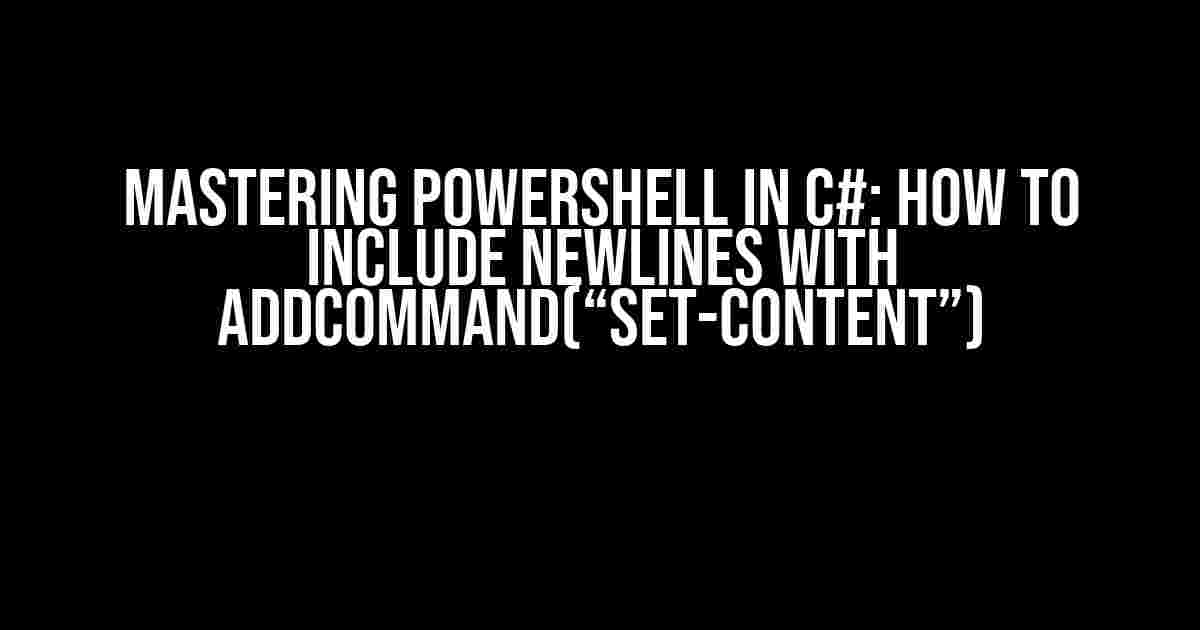Are you tired of dealing with cryptic PowerShell errors in your C# application? Do you want to learn the secret to including newlines with the `AddCommand(“Set-Content”)` method? Look no further! In this comprehensive guide, we’ll take you on a journey to master PowerShell in C# and conquer the newline conundrum.
The Problem: AddCommand(“Set-Content”) and Newlines
When working with PowerShell in C#, you might encounter an issue where newlines are not being included when using the `AddCommand(“Set-Content”)` method. This can lead to frustrating errors and mysterious bugs. But fear not, dear developer! We’re about to demystify this problem and provide you with a solution that will make your code shine.
Why Do We Need Newlines?
Newlines are an essential part of formatting text output. They help create readable and organized text, making it easier for users to understand and work with the output. Without newlines, your text output can become a jumbled mess, leading to confusion and frustration.
Understanding the AddCommand(“Set-Content”) Method
The `AddCommand(“Set-Content”)` method is a powerful tool in the PowerShell arsenal. It allows you to set the content of a file or stream, providing a flexible way to work with text data. However, when it comes to including newlines, things can get a bit tricky.
using (PowerShell PowerShellInstance = PowerShell.Create())
{
PowerShellInstance.AddCommand("Set-Content");
PowerShellInstance.AddArgument("path/to/file.txt");
PowerShellInstance.AddArgument("Hello, World!");
PowerShellInstance.Invoke();
}
In the example above, we’re using the `AddCommand(“Set-Content”)` method to set the content of a file named “file.txt” to “Hello, World!”. However, if we want to include newlines in the output, we need to take a different approach.
The Solution: Including Newlines with AddCommand(“Set-Content”)
So, how do we include newlines with the `AddCommand(“Set-Content”)` method? The answer lies in using the `@` symbol and an array of strings. This allows us to specify multiple lines of text, each separated by a newline character.
using (PowerShell PowerShellInstance = PowerShell.Create())
{
string[] content = new string[] { "Hello, World!", "This is a new line.", "And another one." };
PowerShellInstance.AddCommand("Set-Content");
PowerShellInstance.AddArgument("path/to/file.txt");
PowerShellInstance.AddArgument(content);
PowerShellInstance.Invoke();
}
In this example, we’re creating an array of strings, each representing a line of text. We then pass this array to the `AddArgument()` method, which will include newlines between each line.
Using Environment.NewLine
Alternatively, you can use the `Environment.NewLine` property to include newlines in your text output. This approach is more flexible and allows you to easily switch between different newline characters (e.g., `\n` or `\r\n`).
string content = "Hello, World!" + Environment.NewLine + "This is a new line." + Environment.NewLine + "And another one.";
using (PowerShell PowerShellInstance = PowerShell.Create())
{
PowerShellInstance.AddCommand("Set-Content");
PowerShellInstance.AddArgument("path/to/file.txt");
PowerShellInstance.AddArgument(content);
PowerShellInstance.Invoke();
}
In this example, we’re using the `Environment.NewLine` property to include newlines between each line of text. This approach is more concise and easier to read than the previous example.
Common Pitfalls and Troubleshooting
When working with PowerShell in C#, it’s easy to encounter errors and issues. Here are some common pitfalls to watch out for:
- Incorrect syntax: Make sure to use the correct syntax for the `AddCommand(“Set-Content”)` method. Double-check your code for typos and syntax errors.
- Argument order: Be careful with the order of your arguments. Make sure to pass the correct arguments in the correct order.
- File path issues: Ensure that your file path is correct and the file exists. Use the `Path` class to help with file path manipulation.
If you encounter any issues, try using the `PowerShellInstance.Streams.Error` property to catch and display any errors that occur during execution.
PowerShellInstance.Streams.Error.Informational += (sender, eventArgs) =>
{
Console.WriteLine("Error: " + eventArgs.Message);
};
Conclusion
In this comprehensive guide, we’ve demystified the process of including newlines with the `AddCommand(“Set-Content”)` method in PowerShell. By using the `@` symbol and an array of strings or the `Environment.NewLine` property, you can easily include newlines in your text output.
Remember to watch out for common pitfalls, such as incorrect syntax and argument order, and don’t hesitate to use the `PowerShellInstance.Streams.Error` property to catch and display errors.
With this newfound knowledge, you’re ready to tackle even the most complex PowerShell tasks in C#. Happy coding!
| Method | Description |
|---|---|
| AddCommand(“Set-Content”) | Sets the content of a file or stream. |
| Environment.NewLine | Returns the newline character used by the current environment. |
References:
- Set-Content (Microsoft PowerShell Documentation)
- Environment.NewLine (Microsoft .NET Documentation)
Frequently Asked Question
Get the scoop on how to include newlines with PowerShell.AddCommand("Set-Content") in C#!
Why do I need to include newlines with PowerShell.AddCommand("Set-Content") in C#?
When using PowerShell.AddCommand("Set-Content"), you need to include newlines to ensure that your content is formatted correctly. Without newlines, your content will be displayed as a single line, which can be difficult to read and understand. By including newlines, you can control the formatting of your output and make it more readable.
How do I include newlines with PowerShell.AddCommand("Set-Content") in C#?
To include newlines, you can use the `\n` character in your C# code. For example: `PowerShell.AddCommand(“Set-Content”, “path/to/file.txt”, “Content with\nnewlines”);`. This will create a new line after the word “with” and continue with the word “newlines” on the next line.
What if I want to include multiple newlines with PowerShell.AddCommand("Set-Content") in C#?
To include multiple newlines, you can use multiple `\n` characters in sequence. For example: `PowerShell.AddCommand(“Set-Content”, “path/to/file.txt”, “Content with\n\n\nnewlines”);`. This will create three new lines after the word “with” and continue with the word “newlines” on the fourth line.
Can I use other characters to include newlines with PowerShell.AddCommand("Set-Content") in C#?
Yes, you can use other characters to include newlines. For example, you can use the `Environment.NewLine` property, which returns the newline character(s) for the current environment. For example: `PowerShell.AddCommand(“Set-Content”, “path/to/file.txt”, “Content with” + Environment.NewLine + “newlines”);`. This will create a new line after the word “with” and continue with the word “newlines” on the next line.
Is there a limit to the number of newlines I can include with PowerShell.AddCommand("Set-Content") in C#?
No, there is no limit to the number of newlines you can include with PowerShell.AddCommand("Set-Content") in C#. You can include as many newlines as you need to format your content correctly.

